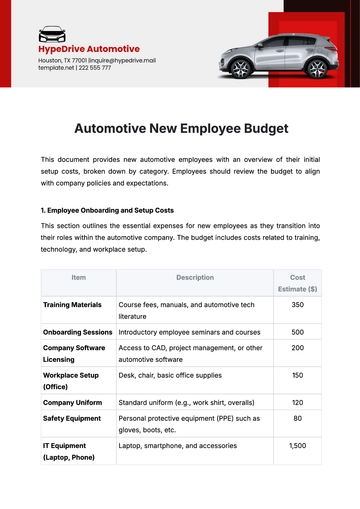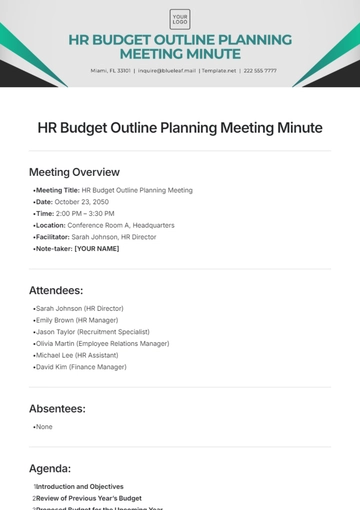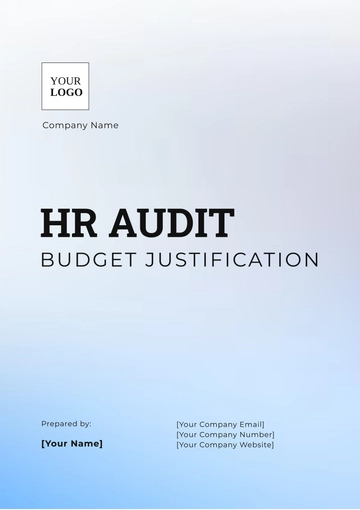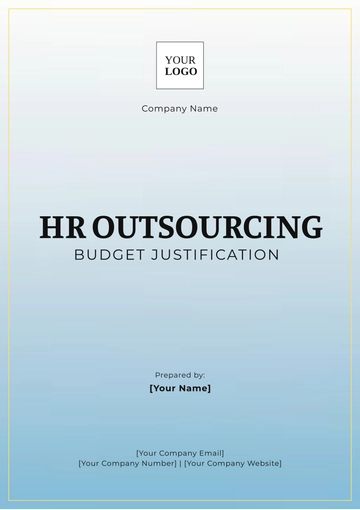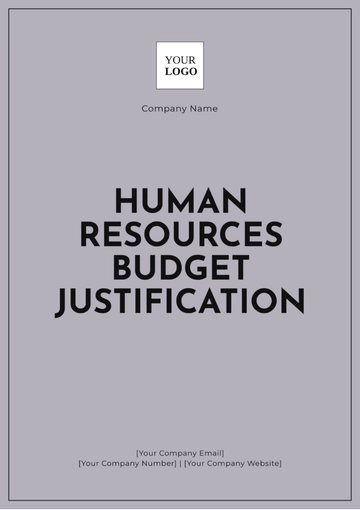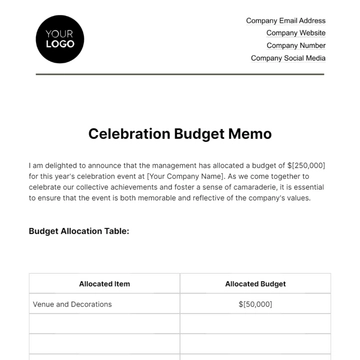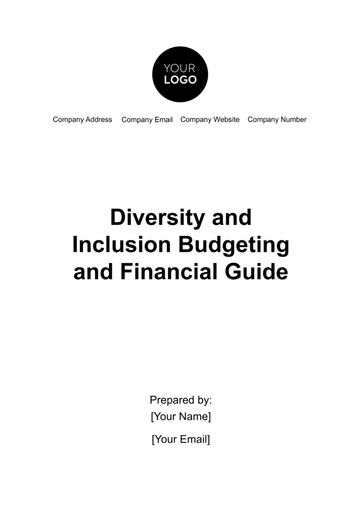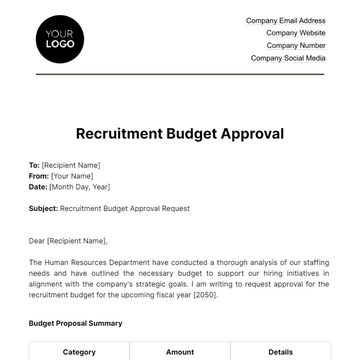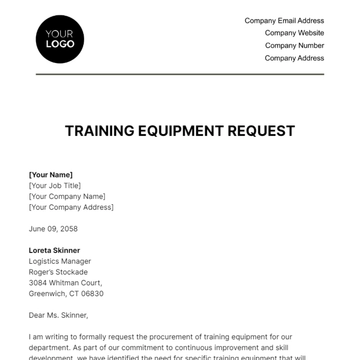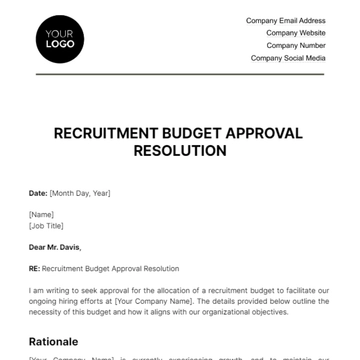Free Human Resources Budget Justification
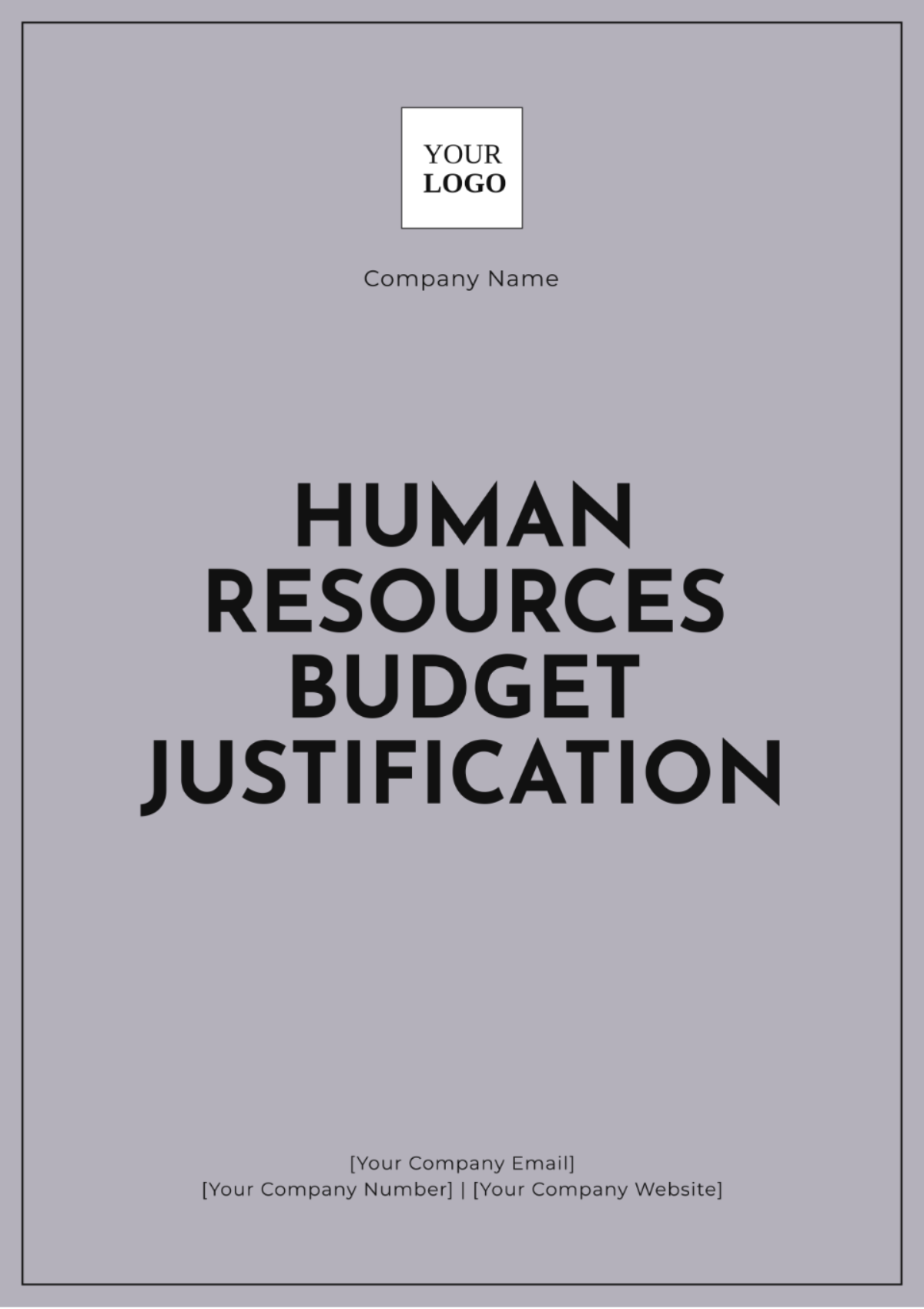
Prepared By: [YOUR NAME]
Date: [DATE]
I. Introduction
The Human Resources (HR) department plays a pivotal role in ensuring the optimal functioning of an organization by overseeing recruitment, training, benefits administration, and employee relations. To align with our organizational goals of enhancing talent acquisition, boosting employee engagement, and supporting professional development, we propose a comprehensive HR budget. This budget is crucial for meeting our strategic objectives and sustaining a high level of operational efficiency within the HR department.
II. Detailed Budget Breakdown
Presented here is a detailed and itemized breakdown of the proposed budget for the Human Resources department for the upcoming fiscal year.
Budget Item | Amount |
|---|---|
Salaries | $1,200,000 |
Training Programs | $200,000 |
Benefits | $500,000 |
Recruitment Costs | $100,000 |
HR Technology and Software | $150,000 |
Employee Engagement Initiatives | $50,000 |
Miscellaneous Expenses | $30,000 |
Total | $2,230,000 |
III. Justification for Each Item
Salaries: Salaries represent the largest portion of our budget and are critical for attracting and retaining skilled HR professionals. Competitive compensation ensures we hire top talent, enhancing our HR effectiveness.
Training Programs: Investment in training programs is essential for the ongoing development of HR staff, improving skills in leadership, compliance, and new technologies. This supports our commitment to continuous improvement.
Benefits: Comprehensive benefits, including health insurance, retirement plans, and wellness programs, are vital for employee satisfaction and retention, reducing turnover and boosting loyalty.
Recruitment Costs: Recruitment costs, such as job postings and agency fees, are necessary to attract high-quality candidates in a competitive job market, supporting our organizational goals.
HR Technology and Software: Investments in HR technology, including HRIS, are crucial for modernizing operations, improving efficiency, and ensuring compliance while providing valuable analytics.
Employee Engagement Initiatives: Providing financial resources for team-building activities, recognition programs, and feedback systems helps maintain high employee morale and productivity.
Miscellaneous Expenses: This covers unplanned expenses like office supplies, professional memberships, and emergency staffing needs, ensuring smooth departmental operations.
IV. Expected Outcomes
The budget that has been proposed is anticipated to result in a variety of beneficial outcomes, comprising several positive impacts such as:
The process of drawing in and securing highly skilled and top-tier talent is achieved through the implementation of attractive and competitive salary packages complemented by well-thought-out and comprehensive recruitment strategies.
Improving and augmenting the abilities and efficiency of employees can be achieved by implementing specific and strategic training programs that are designed to address the particular needs and goals of the workforce.
Improving employee satisfaction and retention by providing comprehensive benefits and engaging initiatives that create a positive and productive workplace.
Enhancing the efficiency of human resources operations as well as guaranteeing adherence to regulatory requirements by implementing and utilizing advanced human resources technology and software solutions.
V. Comparison to Previous Budgets
In comparison to the previous fiscal year, this budget reflects a 10% increase in overall expenses. The increase is primarily allocated towards salaries and training programs to address the rising competition for skilled HR professionals and the growing need for continuous learning and development. Additionally, there is a modest increase in the budget for HR technology to replace outdated systems and improve operational efficiency.
VI. Supporting Data
Supporting data includes market research, benchmarking studies, and historical spending patterns:
Market Research: Market analysis indicates a 15% rise in average salaries for HR professionals over the past year, justifying the proposed increase in salary budget.
Benchmarking Data: Benchmarking with similar organizations shows a higher allocation for training programs, suggesting our proposed budget is in line with industry standards.
Historical Spending Patterns: Analysis of previous budgets reveals a consistent underutilization of funds in areas such as recruitment, allowing for reallocation towards more critical needs this year.
VII. Risk Analysis
The proposed budget carries certain risks, including potential overspending in areas of employee benefits and training if unforeseen economic changes occur. To mitigate these risks, we have developed contingency plans which include:
Conduct frequent and systematic reviews of the budget to carefully monitor all expenditures and implement any necessary adjustments to ensure financial stability and compliance with financial goals.
Training programs with a high degree of flexibility, are designed in such a way that they can be reduced or adjusted in scope and intensity as necessary.
Engaging in discussions and negotiations with providers of employee benefits to secure financially efficient options, ensuring that cost savings are achieved without any compromise to the quality of the benefits provided.
In conclusion, the proposed HR budget is designed to meet our organizational goals by investing in critical areas such as salaries, training, benefits, and technology. By doing so, we aim to enhance our HR operations and contribute to the overall success of the organization.
- 100% Customizable, free editor
- Access 1 Million+ Templates, photo’s & graphics
- Download or share as a template
- Click and replace photos, graphics, text, backgrounds
- Resize, crop, AI write & more
- Access advanced editor
Optimize your HR budgeting with Template.net’s Human Resources Budget Justification Template. Fully editable and customizable, this template enables you to create comprehensive budget justifications tailored to your HR needs. Editable in our Ai Editor Tool, it ensures accurate financial reporting and easy adjustments. Perfect for HR managers and financial planners, this template enhances budget transparency and simplifies the justification process
You may also like
- Budget Sheet
- Personal Budget
- Non Profit Budget
- Monthly Budget
- Project Budget
- HR Budget
- Company Budget
- Home Budget
- Weekly Budget
- College Budget
- Business Budget
- Construction Budget
- Small Business Budget
- Hotel Budget
- Annual Budget
- Home Renovation Budget
- Household Budget
- Student Budget
- Grocery Budget
- Marketing Budget
- Corporate Budget
- Startup Budget
- Manufacturing Budget
- Church Budget
- University Budget
- Annual Budget Plan
- Event Budget
- Operating Budget
- Travel Budget
- Food Budget
- IT and Software Budget
- School Budget
- Real Estate Budget
- Sales Budget
- Conference Budget
- Budget Finance
- Freelancer Budget
- Budget Advertising
